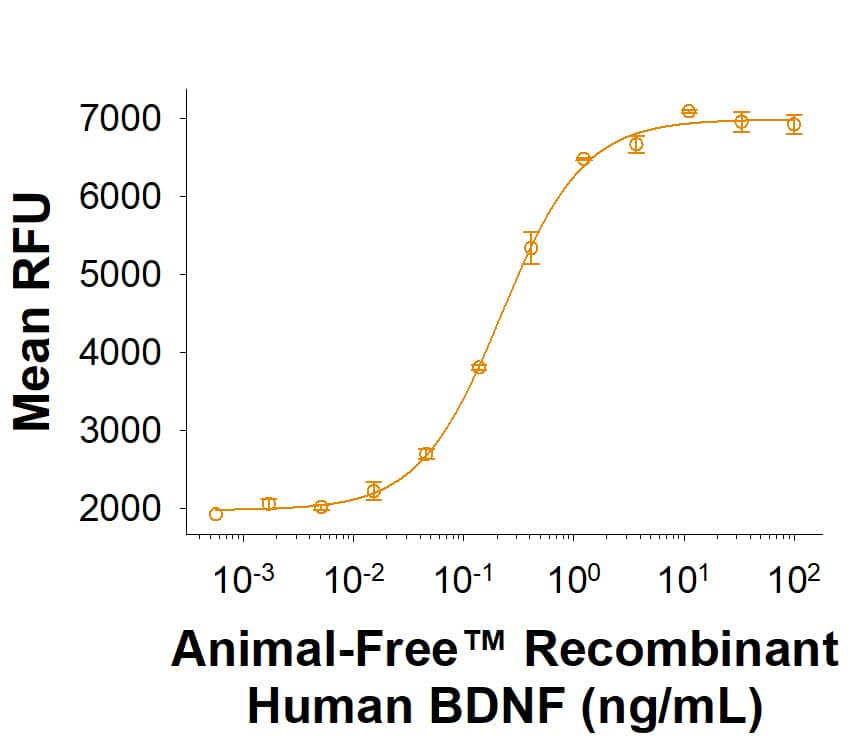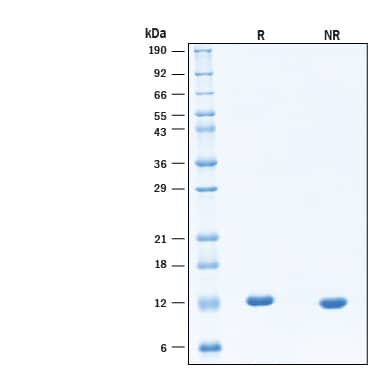Recombinant Human BDNF Protein, Animal-Free Best Seller
R&D Systems, part of Bio-Techne | Catalog # BT-BDNF-AFL

Key Product Details
Learn more about Animal-Free Recombinant Proteins
Product Specifications
Source
E. coli-derived human BDNF protein
Arg134-Arg247, with an N-terminal Met
Produced using non-animal reagents in an animal-free laboratory.
Arg134-Arg247, with an N-terminal Met
Produced using non-animal reagents in an animal-free laboratory.
Purity
>97%, by SDS-PAGE visualized with Silver Staining and quantitative densitometry by Coomassie® Blue Staining.
Endotoxin Level
<0.10 EU per 1 μg of the protein by the LAL method.
N-terminal Sequence Analysis
Met
Predicted Molecular Mass
13.1 kDa
SDS-PAGE
12 kDa, under reducing conditions.
Activity
Measured in a cell proliferation assay using BaF mouse pro-B cells transfected with TrkB.
The ED50 for this effect is 0.100-1.00 ng/mL.
The ED50 for this effect is 0.100-1.00 ng/mL.
The specific activity of Recombinant Human BDNF is >8.0 x 105 units/mg, which is calibrated against the human BDNF WHO Standard (NIBSC code: 96/534).
Scientific Data Images for Recombinant Human BDNF Protein, Animal-Free
Equivalent Bioactivity of GMP, Animal-Free, and RUO grades of Recombinant Human BDNF.
Equivalent bioactivity of GMP (BT-BDNF-GMP), Animal-Free (Catalog # BT-BDNF-AFL) and RUO (BT-BDNF) grades of Recombinant Human BDNF as measured in a cell proliferation assay using BaF mouse pro-B cells transfected with TrkB (orange, green, red, respectively).Animal-Free™ Recombinant Human BDNF Protein Bioactivity.
Animal-Free™ Recombinant Human BDNF Protein (Catalog # BT-BDNF-AFL) stimulates cell proliferation of the BaF mouse pro-B cells transfected with TrkB. The ED50 for this effect is 0.100-1.00 ng/mL.Animal-Free™ Recombinant Human BDNF Protein SDS-PAGE.
2 μg/lane of Animal-Free™ Recombinant Human BDNF Protein (Catalog # BT-BDNF-AFL) was resolved with SDS-PAGE under reducing (R) and non-reducing (NR) conditions and visualized by Coomassie® Blue staining, showing bands at 12 kDa.Formulation, Preparation and Storage
BT-BDNF-AFL
| Formulation | Lyophilized from a 0.2 μm filtered solution in PBS with Trehalose. |
| Reconstitution | Reconstitute the 25 μg size at 250 μg/mL in PBS. Reconstitute all other sizes at 500 μg/mL in PBS. |
| Shipping | The product is shipped at ambient temperature. Upon receipt, store it immediately at the temperature recommended below. |
| Stability & Storage | Use a manual defrost freezer and avoid repeated freeze-thaw cycles.
|
Background: BDNF
BDNF
is often utilized as a cell culture supplement to promote neural
differentiation in regenerative medicine studies and clinical manufacturing
protocols.
The
neurotrophin family is comprised of at least four proteins including BDNF,
nerve growth factor (NGF), neurotrophin-3 (NT3), and NT4/5. Human BDNF is
initially expressed as a proprotein, which is then cleaved to yield a mature
protein. Mature BDNF is a non-covalently linked homodimer, with each monomer
containing antiparallel beta -strands and a characteristic cystine knot motif.
Within the mature domain, human BDNF shares the identical amino acid sequence
with mature mouse and rat BDNF.
BDNF
is strongly expressed in various regions of the brain, including the
hippocampus and cerebellum, and weaker expression has been detected in the
thymus, liver, spleen, heart, and lung. BDNF participates in axonal growth and
pathfinding and in the modulation of dendritic growth and morphology and in
later stages of development regulates synaptic transmission and plasticity and
acts as a central modulator of pain. BDNF binds with high affinity and
specifically activates the TrkB tyrosine kinase receptor. BDNF signaling via
TrkB is essential for adult synaptic plasticity and the formation of memories.
The
BDNF signaling pathway utilizes both AKT and ERK pathways to exert its pleiotrophic
effects in the central nervous system. Decreased expression of BDNF is seen in
many neurological diseases such as Alzheimer's disease, Parkinson's disease,
Huntington's disease, and autism. Further, BDNF is proposed as a biomarker for
psychiatric disorders such as bipolar disease and depression and has been
implicated in posttraumatic stress disorder, phobia, and panic disorder. A
single amino acid substitution, Val66Met, has been shown to lead to reduced,
activity-dependent BDNF secretion and memory impairment.
Long Name
Brain-derived Neurotrophic Factor
Alternate Names
Abrineurin, ANON2, BULN2, Neurotrophin
Gene Symbol
BDNF
UniProt
Additional BDNF Products
Product Documents for Recombinant Human BDNF Protein, Animal-Free
Manufacturing Specifications
Animal-Free Manufacturing ConditionsOur dedicated controlled-access animal-free laboratories ensure that at no point in production are the products exposed to potential contamination by animal components or byproducts. Every stage of manufacturing is conducted in compliance with R&D Systems' stringent Standard Operating Procedures (SOPs). Production and purification procedures use equipment and media that are confirmed animal-free.
Production
- All molecular biology procedures use animal-free media and dedicated labware.
- Dedicated fermentors are utilized in committed animal-free areas.
Purification
- Protein purification columns are animal-free.
- Bulk proteins are filtered using animal-free filters.
- Purified proteins are stored in animal-free containers in a dedicated cold storage room.
- Low Endotoxin Level.
- No impairment of biological activity.
- High quality product obtained under stringent conditions.
- For ex vivo research or bioproduction, additional documentation can be provided.
Product Specific Notices for Recombinant Human BDNF Protein, Animal-Free
For research use or further manufacturing only
